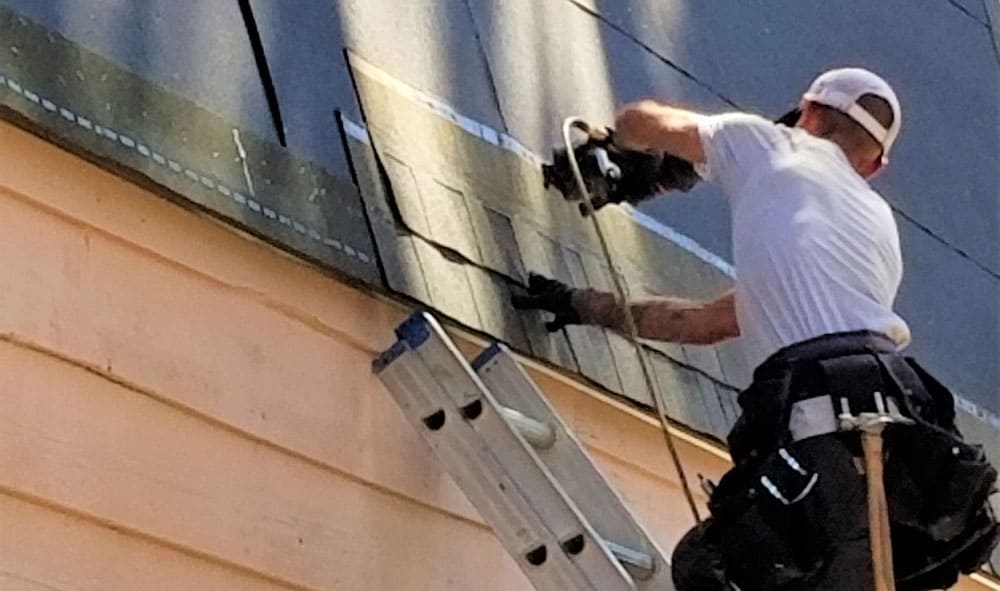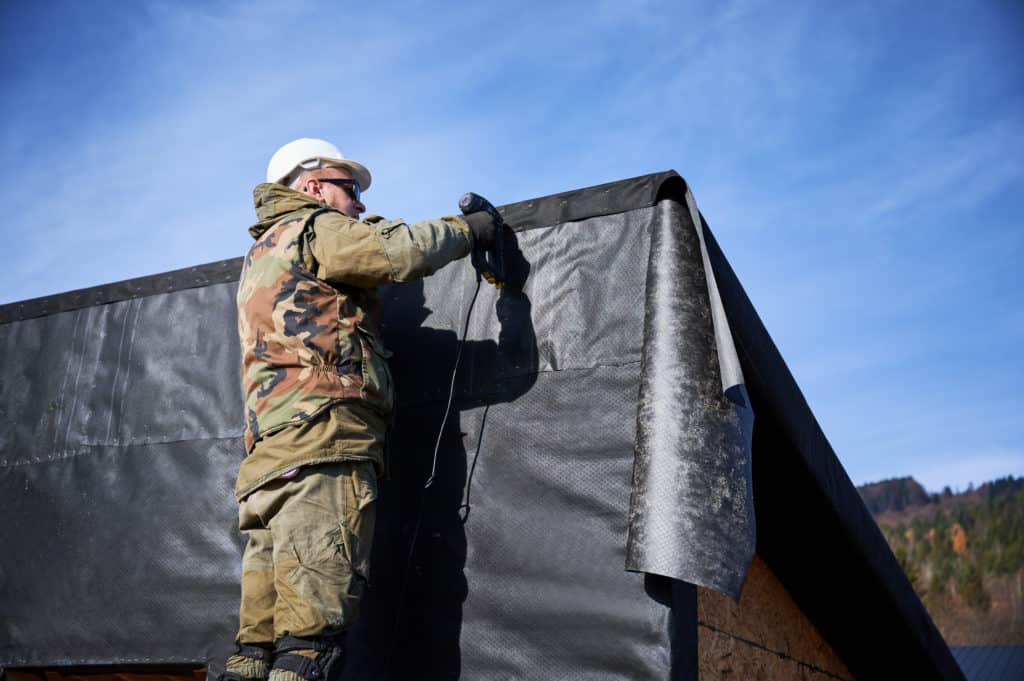When it comes to roofing, it’s essential to know how to check the quality of the work performed. A poorly-built or repaired roof can result in leaks, moisture, and structural damage. You can do a few simple inspections to ensure your roof’s quality.

Installing metal flashing
Water leaks are the number one cause of home damage, so ensuring your roofers install metal flashing around vulnerable areas is crucial. The flashing should be installed underneath the shingles, not on top of them. Step flashing or counter flashing will sometimes be required, so ask your roofer about these options.
Roof flashing is essential for vent stacks, which are often circular penetrations. The flashing around a vent stack must be installed to fit tightly against the surface it protects. The flashing should also be installed over the underlayment or siding, so it does not show from the ground.
Another way to check if your roofers did an excellent roof job is to examine the drip edge. This metal trim fits between the shingles and underlayment and protects them from pests. It also keeps the gutter secure and prevents leaks.
When you hire a roofer to do a new roof, you should ask them to install metal flashing on the roof. The process is not complicated, but it is essential to check the quality of the metal flashing. A good roofer can do this job correctly, and you can tell whether they did an excellent job by checking the quality of the metal flashing.
Roof flashing is an essential part of a roof system. While it looks good on the surface, it may have small holes or existing corrosion, causing leaks. Frequently, flashing is used to seal leaks and protect the roof from damaging elements.

Proper installation of synthetic underlayment
Proper installation of synthetic underlayment is an essential aspect of a roof. It helps protect the wooden components underneath the shingles and is legally required. It is also essential that the underlayment is laid over an attic space that is adequately ventilated. Proper installation will increase the life of your roof.
The right type of underlayment protects the wood and keeps your roof dry during the construction phase. A qualified roofing contractor will use high-quality synthetic underlayment, about 40 times stronger than felt paper. In addition, this type of material is much more durable, as it won’t break down and will stay in good condition. This material also lays flatter than its felt-paper counterparts.
A quality roofer will also install synthetic underlayment between the sheathing and shingles. Synthetic underlayment is the best choice to prevent moisture from leaking through the roof. Its strength and durability will help you extend your roof’s life.
When choosing a synthetic underlayment for your roof, ask about the thickness. The larger the roll, the less time it will take to cover the entire roof. Synthetic underlayment is typically 4 feet long and covers about 1000 square feet. The larger the roll, the faster your roofer can cover the entire roof, requiring fewer trips up and down.
If the roofers did a good job, synthetic underlayment is one easy way to check whether they did well. Many homeowners need to pay more attention to this critical part of the roof installation because it needs to be visible. If the underlayment is installed incorrectly, it could lead to a roof problem. Also, make sure they apply the correct number of nails per shingle. The correct number of nails is four, not two.

Proper installation of shingles
Proper shingles installation on a roof requires understanding the shingles’ placement. For proper installation, the roofer must measure the distance from the eave edge to the top edge of the ridge. Once he has determined this, he can use a chalk line to mark the exact location of the shingles. He should place these lines at five-inch intervals.
Roofers typically use pneumatic nail guns to fasten the shingles on a roof. They should be appropriately used, as the wrong pressure can cause nails to be driven through the shingle at an unnatural angle. They should also install the shingles in a stepped or staggered pattern. This is important because the shingles must be offset from each other or risk the water seeping in. Improperly installed shingles can also affect the aesthetics of the roof. They may be loose and wavy, which can cause water damage or even blow-offs.
Roofers should also use waterproof underlayment. This helps prevent water from seeping through the shingles and into the house during severe weather. This material can be purchased at a home center or roofing supply store. Depending on your area’s climate, it should be applied at least three feet from the eave.
Before beginning installation, the roofer should measure the size of the roof. In general, a roof has about 2,000 square feet of area. The number of bundles will depend on this amount. The length of the roof will affect the number of shingles needed to cover the entire roof. For example, a three-foot-long asphalt shingle will cover 20 squares.
Checking for sagging rooflines
Sagging rooflines indicate structural problems and need professional repair. A sagging roof may have several causes, including excessive weight, poor installation, or age. Sometimes, a sagging roof can be repaired with additional support.
Rooflines that are sagging can be a sign of damage to rafters or trusses. It is essential to note the extent of the problem as this will determine the repair cost. If the damage is minor and contained to a small roof section, it can be repaired more cheaply. Before contacting a roofing company, walking around the entire house and taking photos of damaged structural beams or trusses is a good idea. Also, check the plywood and metal gusset plates for damage.
Another sign of a sagging roof is a bow or humps on the roof plane. If the roof has multiple shingles layers, they may not be level. A roofer can remove excess shingles and inspect the flashing and underlayment. Sagging roofs are also a sign of a foundation problem.
If your roof is sagging, water damage may be to blame. The weight of water on a roof can weaken the rafters and deck. After several seasons, this could lead to a collapse of the roof. In addition to replacing shingles, you may need to repair gutters and improve ventilation in the attic.
Sagging rooflines are easy to spot from the ground. A properly installed roof will look even and straight. If it’s sagging along the roofline, your roofers likely should have paid more attention to the framing of your home or taken more time to inspect the roof properly before laying the new roof. This could lead to further damage if the new roof isn’t correctly installed.
Checking for leaks
You should be aware of leaks and how to spot them before hiring a roofing company. The most apparent leak signs are water stains and watermarks. They can be as small as a drop on a candle or larger and affect the house’s interior. You can also tell there’s a leak if you notice water dripping on the insulation in your attic.
A damaged chimney seal can also cause leaks. A professional roofer can pinpoint the source of the leak and provide a solution. In some cases, water can also enter the attic through electrical wiring. While an overhead leak is unlikely to cause interior water damage, you should have it checked by a professional roofing company.
A leaky roof can be an expensive matter. Even the most minor leak can cost thousands of dollars. Fortunately, there are methods to detect leaks quickly and easily. Leaks in roof membranes constitute a significant cause of billions of dollars in repair costs each year.
Leaking roofs can be challenging to detect and repair. Even if you’ve had a professional roofer perform initial inspections, they may fail to detect the leak. Moreover, leaks can occur for different reasons, so detecting the source of a leak can be difficult. Sometimes, the leak may come from a place near the damaged roof.



